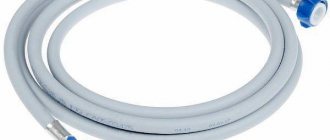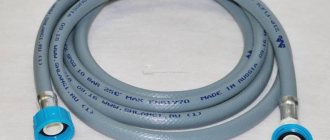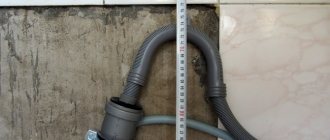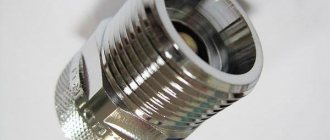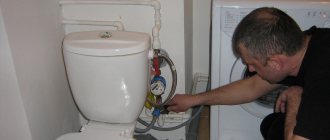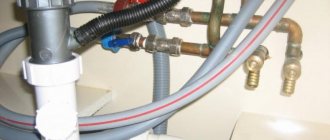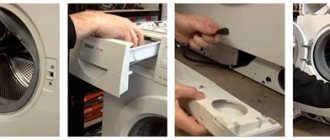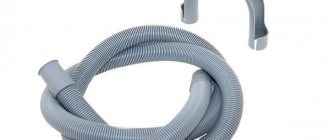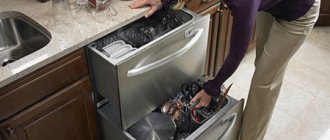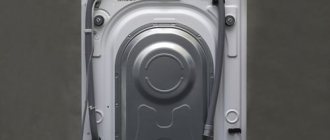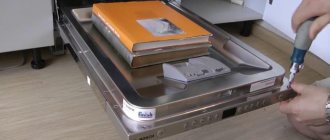Modern science does not stand still; the days of spending a long time in the kitchen in front of the sink are a thing of the past: the tedious washing of dishes by hand has been replaced by an automated machine. A dishwasher has rightfully become an important attribute in the kitchen, so its purchase is a kind of holiday for housewives. Connecting the “dishwasher” is the main step before putting it into operation. It is important to familiarize yourself with its characteristics and instructions for use before starting to use it.
Dishwasher hoses: filler and drain must be included. The manufacturer gives them a good warranty, so factory defects are extremely rare.
There are all sorts of circumstances in life: it may turn out that hoses are not included in the components; either they will be short; or a defect has arisen, and one of them has become leaky and needs to be replaced. In this case, it is useful to know how you can select a hose, replace it, or lengthen it.
Characteristics of water supply hoses
In the operation of a dishwasher, hoses (sleeves) supplying cold or hot water inside the unit play a major role; without them, the machine will not work. It is important to recognize the defect in time and take measures to eliminate it. The drain line also plays an important role: it performs the function of discharging dirty water after the end of the dishwashing cycle. If deviations occur in the operation of this hose, the speed of operation may decrease, an unpleasant odor may appear, or the equipment will stop working.
If a problem occurs on one of the dishwasher arms, it needs to be replaced. Before purchasing it, it is advisable to decide on the length and calculate the distance from the sink to the car. It must be remembered that the hose cannot be connected using the tension method, as mechanical defects may occur in the future, which will lead to water leaks. Sleeves are available in lengths from 1.5 to 5 meters, the most optimal length is 2-2.5 meters, they are sold by the meter.
Inlet hoses have a technical passport, which includes all their characteristics: maximum permissible water pressure, operating pressure and temperature. The numbers are indicated on the sleeve itself if there is no passport. The water supply hose is usually made of polyvinyl chloride (plastic); at its ends, parts with a union nut are installed for connecting pipes - fittings. These parts can be angular (they are usually used for fastening in the dishwasher) and straight. There are rubber and reinforced filling hoses. Rubber – additionally reinforced with nylon or metal. The most popular are plastic sleeves; buyers are especially attracted by their price, and besides, they are quite practical.
Typically, the operating temperature of hoses in cold water is 20-250C, in hot water – 60-700C. For apartments choose filling hoses designed for pressure up to 20 bar, for private houses and cottages - by 10%. more. Some water supply lines are equipped with a special design that protects the dishwasher from leaks - the Aquastop valve. The cost of such systems is several times higher than conventional structures. If desired, this sleeve can be installed instead of the drain, this will significantly increase safety and reliability. It is advisable, before installing the system with the Aquastop device in place of the drain hose, to install filters that can retain dirt and prevent blockages. This will extend the life of the machine.
The drain hose is made of polypropylene, length – up to 5 meters. When choosing it, it is necessary to take into account that the diameter of the pipe outlet must match the diameter of the fittings for the connection. You need to know that if the drain line is made in a telescopic design, then the corrugation will stretch, and it does not need to be extended if there is not enough length. If water leaks from the hoses on the dishwasher, it is advisable to completely replace them, since the repair and sealing will not last long.
Kinds
The dishwasher comes with filler and drain hoses. In this case, dishwashers and washing machines are absolutely similar. Before connecting the pipes, they must be checked to see if they are intact. The instructions should show what kind of leakage protection exists. The inlet hose for a dishwasher is equipped with a valve; if it is not working properly, then it will not even be possible to draw water into the machine. You will need a dishwasher hose with aquastop in case it gets torn off the fitting. Today there are effective systems against water leaks from Bosch and Electrolux; their diagrams are shown in the photo.
Water supply
Water comes through a separate outlet. You can connect the dishwasher water supply hose according to the following plan:
- A filter is placed on the tap water pipe in the dishwasher that does not allow sand particles and rusty metal fragments to pass through;
- If the dishwasher is not protected from leaks, when connecting the device, it is necessary to install a unit with a shut-off valve before the filter and turn off the water after each dishwashing cycle. In this way, it will be possible to protect yourself from an emergency so as not to harm yourself or your neighbors;
- A more progressive way to protect against surprises is to install a device called aquastop, then there will be no need to use the shut-off valve, each time wasting your time and worrying that you suddenly forgot to close it.
If the pipes included in the package are shorter than necessary, you can lengthen them yourself and replace them. An extension cord is required for this. Some models are connected to hot water pipes. This provides significant energy savings on water heating. But this approach is not acceptable in Russian conditions, since according to existing standards, process water is saturated with anti-corrosion substances that resist rusting of water pipes. And this, in turn, has a detrimental effect on the operation of the machine.
Electricity supply
The main power in the dishwasher is consumed by a tubular electric heater (hereinafter also referred to as heating element), which heats the water to the desired temperature. During its operation, the PMM consumes from 2 to 3 kW of electricity. You can find out about this from the technical documentation or see this parameter on a sticker located on the machine body (see photo below).
The label indicates the power of the Hansa compact PMM - 1.93 kW
In accordance with these indicators, the outlet must withstand a current of at least 16 A. Moreover, it must be located in a place to which there is easy access. There are two placement options: slightly above the furniture countertop (in the case of a built-in PMM) or in an adjacent niche, while the distance to the sink should be at least 0.5 m (due to possible water ingress). One more rule must be observed: the outlet should be located no further than 1 m from the dishwasher.
The ideal layout of communications is shown in the figure below, where:
- PMM housing.
- Area of connection to the electrical network.
- The area where the PMM connects to the water supply system.
- Drainage area.
Diagram of the correct connection of the dishwasher to communications
A dedicated line must go to the outlet from the distribution panel. If it is not laid, and the apartment has already been renovated, run the wire along the wall and cover it with a decorative box. At the same time, the appearance of the interior will not be affected. The same line can be used to connect a washing machine, provided that it does not turn on at the same time as the PMM.
One of the options for connecting the dishwasher to the mains
For installation, you need to use a cable with stranded copper conductors (for example, brand VVG-nG-Ls) with a cross-section of 2.5 mm2. A residual current device (hereinafter also referred to as RCD) must be present, along with circuit breakers that operate at a current of 16 A. By the way, RCDs and circuit breakers can be replaced with one differential circuit breaker.
The need to install these devices is due to the fact that there is a danger of a short circuit in the electrical network with water and electric shock to people.
RCD and differential circuit breaker
Parameters of the protective device: 25 A, shutdown current - 10 mA. You can use an RCD with 16 A and 30 mA leakage current. The connection is performed in the same way for PMMs of a wide variety of brands: Bosch, Siemens, Electrolux, Indesit, Whirpool and others.
Replacing hoses on a dishwasher
Preparing to replace them
To prepare the dishwasher for replacing the hoses, you need to: turn it off from the power supply (check the display that it is inactive), turn off the water supply valve, spread a large rag or cellophane in case of draining the remaining water, disconnect it from the sewer. Tools for work - pliers, screwdrivers, adjustable wrench, wrench.
When everything is prepared and sleeves of the required length have been purchased, you can, if possible, pull out the machine and disconnect the lines.
Replacing the inlet hose
The filling hose is connected to hot or cold water and passes it into the chamber. Different types of water supply hoses are installed on different models of “dishwashers” (Electrolux, Hansa, Beko). On almost all dishwasher models, the filling hose is attached to the bottom wall of the housing at the back of the machine (Samsung, Hotpoint Ariston models). Replacement is quite simple: you need to carefully unscrew the hose nut, move the old hose to the new one, and tighten it.
There are models of “dishwashers” in which the water fill line runs inside the body of the model. In this case, a small disassembly of the case is required; the car should be turned over or placed on its side, this will be more convenient. It is necessary to disconnect the front strip from below and the bottom itself. As a result, there will be access to internal components. At the front wall of the housing, the sleeve is connected to the fill valve; it must be disconnected from the valve with a wrench, a new one must be installed and screwed on.
If you want to install Aquastop protection, it is important to know that it comes complete with the sleeve and cannot be installed separately.
Replacing the drain hose
The drain hose is connected to the dishwasher both from the bottom left and bottom right, it all depends on the model.
If all communications are disconnected from the dishwasher, in order to clean or replace the sleeve, unscrew the screws on the lower front wall with a wrench, then remove the panel and plate. Next, we proceed to the junction box: remove the wires and remove the cover. Remove 2 screws from the brackets securing the dishwasher in the hole in the niche where it is installed. The machine can be pulled out from under the rack, but for this it is necessary that the filler and drain lines sag well: it is advisable not to damage them. Unscrew the clamps using pliers. It is best to place the car on its side, unscrew the screws, and remove the pan.
Tools
To replace components, you will need a set of tools, including:
- screwdriver;
- clamps;
- pliers;
- fum tape;
- adjustable wrench;
- filter;
- impact wrench
Protective gloves and towels may also be useful.
Set of tools
How to extend dishwasher hoses
If there is a need to lengthen the hose due to a change in location of the dishwasher or for another reason, then you need to have an idea of its technical characteristics, calculate the length by which you want to increase the diameter, and purchase a filler or drain hose with the required parameters. To work, you will also need a coupling and three clamps.
For reliability, it is better to use a brass coupling rather than a plastic one.
Water supply hose extension
All communications and power to the dishwasher are turned off. The filler hose that comes from the dishwasher is first attached to one side of the coupling, and a hose extension is screwed onto the second side of the coupling, which is connected to the water supply line. It is advisable to change all worn rubber bands, coat the fastening points with an anti-corrosion solution, and check the operation of the hose.
How to lengthen?
If the machine is equipped with a hose that is too short, it can be extended. To do this, perform the following chain of actions:
measurements are taken to determine how much the tube needs to be extended - the length of the system for safe operation should not exceed 3 m;- purchase an inlet hose of the desired length and quality, as well as a connecting coupling (nipple), preferably brass rather than plastic;
- if the hose is extended without the Aquastop system, the hoses are connected into a single unit using a coupling, then connected to the water supply and dishwasher in the standard way described in the paragraph above;
- if a product with the Aquastop system is extended, a regular hose (without Aquastop) is additionally purchased, the elements are connected in a chain so that the hose with Aquastop is connected to the water supply, and the regular hose is connected to the dishwasher; the reverse order is not allowed.
The additional connection increases the risk of water leakage, so it is recommended to replace the hose whenever possible rather than extend it.
Drain hose extension
There are no difficulties in extending the drain hose on a dishwasher. After preparing it and taking measurements, you need to purchase a sleeve - connector of the required length. Using simple movements, connect the old hose to the new one. By carrying out such manipulations, you can lengthen the drain hose to larger sizes. Mechanics and specialists who repair dishwashers advise not to lengthen the water supply hose, especially in several places, but to change it, since the risk of water leakage is still present.
Diagnostics and maintenance
For long and uninterrupted operation of the dishwasher, it is important to periodically examine the condition of the inlet hose, as the most vulnerable part of the unit.
With regular use, diagnostics are done at least once every 1.5-2 months, which allows you to notice changes in time and prevent larger problems.
At home, diagnostics and maintenance include the following:
The main parameter is tightness (no leaks).
Evaluated during operation of the device. If the tube is leaking, replacement is required. Experts do not recommend sealing the leak site - it is unreliable and will lead to a more serious leak after a while.- Due to kinks or improper installation of the tube, blockages may form in it. The first sign is a difficult water supply, even to the point of stopping. A radical solution to the problem is to replace the element with a new one.
- If the dishwasher refuses to perform its duties and there is no water supply, in most cases this means that the Aquastop system has worked and the hose will also need to be replaced.
The cause of rupture and leakage is often not normal wear and tear, but a bend point that could not withstand the increased pressure on the narrowed passage.
The main factor for long-term operation is proper installation and connection to the dishwasher. It is also important to make the tube difficult to access: this will prevent accidental mechanical damage.
Replacement
How to extend the dishwasher hose? First you will need to measure the distance from the dishwasher to the drain point. Then you should purchase an extension cord of the required length, 25mm in diameter, three clamps and a connecting fitting. Clamps are put on the ends and on the siphon and connected to the fitting.
When replacing a damaged hose, purchase a new one of the required length and clamps with a diameter of 30 mm. First, remove the check valve c. Then the hose itself is unscrewed from the back panel, having first removed 6 screws and removed the sleeve. Next, a new hose and clamp are installed. The two parts of the sleeve are connected and it is inserted into the back panel. The screws are also secured in place.
First run
When the dishwasher is connected to the power supply and the inlet and drain hoses with aquastop are connected, you should “run” the machine for the first time without loading dishes. Thereby check the correct connection of all communications, namely -
- How quickly water is poured into the machine;
- How water is heated;
- Checking the drying process.
The first cycle of turning on the dishwasher is carried out with the presence of all detergents and special detergents. Thus, it will be checked how tightly all joints and bends are connected.
When the dishwasher has been tested at home - the hoses remain intact and do not leak, you can congratulate yourself on the successful connection.
Cleaning hoses from blockages
During operation, sometimes problems arise with the flow or drainage of water.
In this case, it is important to check the hoses for water leaks or try to clear the blockage from the hose. In the latter case, men will have to take tools and work a little. First you need to disconnect the dishwasher from the communications and turn off the power. We disconnect the required sleeve and begin cleaning it with a brush. In case of severe contamination, the hose can be soaked in a solution of weak acid or alkali, then use the brush again. It is advisable to remove all contaminants from the inner surface to reduce the likelihood of future leaks. After cleaning, you can put the hose back in place. If after cleaning the problem with the flow and drainage of water remains, the hose needs to be replaced.
It turned out that replacing hoses on a dishwasher is not as difficult as it seems at first glance, the main thing is to select all the components for this correctly and in accordance with the characteristics. It is important to promptly check the water supply and drainage lines at the “dishwasher” for serviceability.
All household appliances do not last forever; all devices have their own specific service life, after which they may fail. To prolong their life, it is necessary to properly and promptly care for them and comply with all parameters recommended by the manufacturer.
What functions does it perform?
In order for the dishwasher to work properly, it is connected to electricity, water supply and sewerage.
For normal operation, you cannot do without an inlet hose: it supplies water, and this is its main function.
Many people don't even realize that the filler tube performs another important task . The water supply network operates under significant pressure, and water hammer (a sharp, sudden increase in internal pressure) cannot be ruled out.
To protect the device, it is equipped with a protection system, and the inlet hose is part of it.
Manufacturers of modern household appliances use a reliable double system to protect equipment from leaks. It is triggered if unforeseen circumstances arise, shutting off the water and saving the owners from the flood and the neighbors living on the floor below.
The system is implemented as follows:
- Internal protection . AquaControl system with float sensor.
- External protection . AquaStop system. The hose connected to the water supply is equipped with a special inlet valve, which can interrupt the water supply in case of force majeure.
How to connect a dishwasher
Choosing a location
You need to choose the location of the equipment before purchasing the PMM. If you decide to build a dishwasher into your kitchen furniture, you need to know the dimensions of the corresponding niche. It can be located under the countertop, cooking panel or under the sink .
Approximate size ratio of niche and built-in dishwasher
The place to install the dishwasher should be close to the sink , which is already connected to the water supply and sewerage system. If the distance to communications exceeds 1.5 meters, problems may arise in the operation of the device.
Washing machine and dishwasher built next to the sink
Make sure that there is an electrical outlet . Since the dishwasher consumes quite a lot of electricity, it is dangerous to use an extension cord to operate the PMM, especially if several devices will be connected to it.
The extension cord must not be placed behind the rear wall of the PMM
For a compact dishwasher that can be placed directly on the countertop, the issue of supplying communications is easier to solve, since it can be easily placed as close to the sink as possible. This option is optimal when there is no niche with the required dimensions in the furniture. There is no need to make a connection to the sewer at all; just place the drain hose in the sink.
Attention, important!
Never cut this hose or immerse the plastic solenoid valve housing in water.
To avoid an electrical accident and leaks, lay the inlet and drain lines so that the hoses do not bend and are not adjacent to the heating elements. It is best to mask these technical communications with hard plastic “false panels” to prevent even the unlikely impact of children or pets.
Basic rules for installing a Bosch dishwasher
There are no special connection secrets - you need to ensure water supply and drainage.
The general installation procedure is as follows:
external inspection, checking components;- preparing the installation site and hose outlet;
- if the machine is built-in, then you need to screw on the facade and a metal plate for thermal insulation (it is included in the kit);
- Bosch machines come with a rubber apron that is screwed on at the bottom. It is covered with a façade and provides additional sound insulation;
- sewer connection;
- connection to water supply;
- adjustable legs;
- Plugging in and checking operation. Be sure to inspect the connections. There should be no leaks.
Frequent problems with the product
Common water hose problems include the following:
- Water leak . If a small puddle (not condensation) regularly forms under the machine, you should check the hose. The cause may be a crack in the tube itself, a broken seal, or a slight loosening of the clamp at the connection. In the first case, the product is replaced with a new one; The seal can be changed if possible, and the clamp can be tightened.
- The machine does not take in water . Clearly a problem with the filling system. It is necessary to check the inlet filter, the hose itself, the inlet valve of the machine, and remove blockages.
- Triggering of Aquastop protection . The cause may be damage to the integrity of the tube, resulting in water leakage. Then the hose must be replaced.
